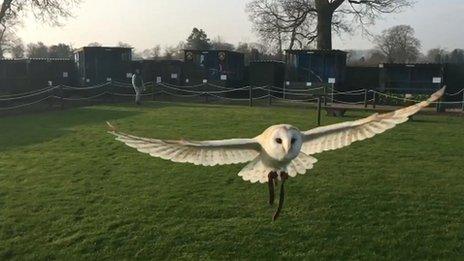Baby boom brings barn owls back from the brink
- Published
- comments

I love barn owls.
The little owl may be more adorable and the eagle owl more impressive but watching a pale barn owl floating silently across the fields is one of the UK's nature wonders.
And they really do float silently. I've been filming with Molly, a rescue barn owl, and she decided to take a bit of a detour while showing off for our cameras.
Skimming past my gauntleted glove she landed on a fence post right by producer Karen's head.
Karen, busy watching what the cameraman was filming, didn't even hear her arrive.
So for barn owl fans like me the last few years have been pretty difficult. In 2013 numbers fell to their lowest levels. In Staffordshire they recorded just 15 breeding pairs. Starving to death in unseasonal snow and running out of barns and trees to live in, things did not look good.
Can the species survive?
There comes a point where you have to wonder if a species can continue to survive on a widespread scale or if they will retreat to a few isolated pockets here and there.
So I've been back to Staffordshire for BBC Inside Out to see how people who love our barn owls are making a real difference. And if barn owls can come back from the brink.
One of the interesting things about barn owls is how little we actually know about them. So while barn owl boxes are vital for providing homes they also act as one way to try and track and monitor the birds. In Staffordshire the Barn Owl Action Group has put up more than 400 and knowing their locations they can get a really good idea of how the population is doing.
Surprisingly mysterious
But fundamental stuff, like where chicks go when they fledge and how far the adults move, is actually not that clear. It is a "citizen science project" waiting to happen as one expert told me. We ring a lot of barn owl chicks, but then recover hardly any ringed birds. And we're not really looking into the data we do have in the best ways.
Even high tech tracking might not answer these questions as it's not that obvious where you'd put the tech on the owls.
So here we are. With a beautiful bird of prey that had a terrible year in 2013 and that we know surprisingly little about.
Good news
Well, we still don't know the answer to some of the big questions, but the latest research pulled together by the Barn Owl Trust does contain good news. It seems the barn owl is fighting back. 2014 was an excellent year seeing more barn owls breeding and also having bigger broods.
So with more owls out there now is great time to go and see them. Keep your eyes peeled at dawn and dusk around hollow trees, old barns or new boxes. Barn owl groups are very interested in sightings in unusual places like towns and cities. If you see one let them know via the barn owl survey website, www.barnowlsurvey.org.uk
But do keep your eyes peeled, because you haven't a chance of hearing them flying past.